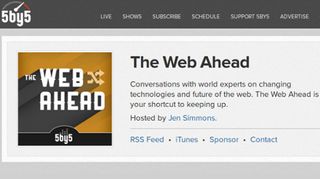The best of January's web design podcasts
The death of the agency, developer drama, the ruination of online discourse… we round up the best bits from the month's podcasts.
Two weeks ago Dylan Wilbanks wrote an article on The Pastry Box lamenting the recent intensification of online viciousness and declaring that 2015 should be "the year we fight back, the year of empathy". He's not the only one thinking this way; this sentiment is a thread that runs through much of the conversation taking place around web design at the moment.
In the podcasts this month, Eric Meyer discusses his new talk, 'Designing for Crisis' in which he highlights the issue of users in crisis. How many websites design for visitors who arrive in a state of anxiety, bewilderment and shock? Not many, it turns out, even when those sites are likely to receive a significant volume of users in that state.
Over on CodePen Radio, the team discuss their process for dealing with mistakes and the idea of 'the blameless postmortem', which encourages engineers to reveal the real truth about how things went wrong, as opposed to making them feel that they need to cover their backs.
Back-covering is a sure-fire recipe for future mistakes. Information architect Abby Covert talks to Jen Simmons about the need for designers to recognise how their own personal worldview impacts their work, and how they need to examine the mental models of those they serve. This Developer's Life asks why developer drama is so intense. On the current state of online community, Andy Budd says: "We wanted to build a perfect city, but we've ended up creating ghettos, silos, no-go areas, the worst kind of communities."
These are troubled times. But there's hope! Maybe design can save the day. Overall there's a call for making things more people-focused, and for increasing efficiency by using more realistic and sophisticated models of how humans work.
CodePen Radio 033: Postmortems

CodePen Radio is the place where the people behind CodePen talk in their lively style about what it's like to run a web software business. In 'the most deadly of episodes we've ever done!" the team discuss what they do in the aftermath of occasions where they've accidentally killed their own website: they do a postmortem.
First we hear about some recent down time that was seemingly caused, as Coyier says, "by a perfect storm of bad things that happened. But of course it's a perfect storm every time one of these things happens." They go on to dissect the errant dev work and outline the measures they've put in place to ensure that this kind of mistake doesn't happen again.
Get the Creative Bloq Newsletter
Daily design news, reviews, how-tos and more, as picked by the editors.
The discussion then gets onto the idea of "the blameless postmortem", a term they credit to Etsy's John Allspaw. In his article Allspaw writes "an engineer who thinks they're going to be reprimanded are disincentivized to give the details necessary to get an understanding of the mechanism, pathology, and operation of the failure. This lack of understanding of how the accident occurred all but guarantees that it will repeat. If not with the original engineer, another one in the future."
Allspaw goes on to explain that blaming people leads to a very counterproductive cycle, and that it's more productive to work with the belief that it's situations, rather than people that cause errors. Whatever the person did wrong made sense to them at the time, and finding out why it made sense to them is key to preventing it from happening again.
The team remark on how since they're still small and "pretty good at all getting our chance at taking down the site somehow", there hasn't yet been a chance for blame to accumulate on any one person, but they recognise that this is good way to work as they grow.
They finish up with with a discussion about the value of writing a postmortem report - it helps you to "think through every step, and you'll internalize the experience better."
The Web Ahead

There have been three episodes of The Web Ahead this month, and they're all worth a listen.
#93: Parsing design with Andy Budd
In #93, Simmons asks Andy Budd the big question: "Where are we right now with design, and where are we going?" Budd tells us that he thinks right now "design is in the best and healthiest place its been in in a really long time". He explains that developers used to be the heros, and that startups were valued on the strength of their technology. But today "there's a real understanding that tech isn't a differentiator any more, because there are so many libraries and resources that can get sites up and running really quickly". He explains that the companies that stand out are those who demonstrate that they have a great understanding of design, and have created something that's difficult to copy. "It's incredibly hard to copy good design. You can copy the surface layer, but good design is something that happens much much deeper."
Budd is glad that these days there is a lot of recognition for UX designers, but he has noticed that UI designers are often undervalued and sometimes feel a pressure to become UX designers. He wants to see a realisation that both fields are important.
He goes on to explain that the industry has a supply and demand mismatch: "There are lots of junior designers who are good at mimicking a style but not good at solving a problem. It's that problem-solving designer that's hugely valuable. If you are that kind of person you're in huge demand; those people are few and far between. The demand is there, but maybe the supply isn't."
Simmons talks about the current state of online discourse and how it might be improved with better design: "We have a problem with the quality of conversation online. What could we replace commenting with? That's a juicy design problem." She mentions The Coral Project, an effort led by people at Knight-Mozilla OpenNews, The New York Times, and The Washington Post to "to improve communities on news sites through open-source software." Simmons says: "They're trying to solve that problem, and see if they can come up with the future of discussion. The public discussion of news in five years could be really helpful and add something to our culture rather than be this crazy comment section."
Budd laments that "We've moved to this weird place where people are joined not by a mutual love but by a mutual hate... we wanted to build a perfect city, but we've ended up creating ghettos, silos, no-go areas, the worst kind of communities."
The episode rounds up with a discussion of animation and in particular animated prototypes. "If you are designing for very small screens, animation and transitions can communicate a huge amount." He declares that the trend will be big: "That's my big tip - if not this year, then next year will be the year of animated prototypes".
#92: Making sense of a mess with Abby Covert
In #92 Abby Covert discusses how information architecture can help you to get a handle on your messes. She and Simmons talk about the weirdness of words, and how the different languages of different departments in an organisation or different stakeholders in a project can prove to be barriers to progress and even sources of conflict. She introduces her book, How to Make Sense of Any Mess, which sounds like a highly necessary resource to us.
Covert argues that we need to educate the next generation of designers with certain soft skills: "To believe, as a designer, that you don't have your own unique way of looking at the world, and that you're not kind of getting it all over your work, it's a bad practice to believe. To be that wrapped up in not understanding the uniqueness of the inside part of us. I think that looking at things like mental models of the people that we're looking to serve — in terms of our users and our stakeholders — is really an important step for any designer to learn how to do."
#91: Designing for crisis with Eric Meyer
If you have a long journey to get through #91 is a hefty two hours with Eric Meyer. In his new talk Meyer discusses how we usually design for ideal users, but in the real world people arrive at websites when they're in all kinds of situations and frames of mind. He says: "I've never seen a persona that's, this person needs to know this information in the next five minutes or they're losing their job. Which is a kind of crisis. If you have an airline site, as an example, this person thought they had tickets booked but they can't find the reservation and they're having trouble logging in and the flight is in three hours."
He goes on to describe a situation in which he was travelling unexpectedly to an unknown hospital. "I have yet to see a hospital website that has somewhere on its website, prominently featured, a box that says, 'Are you coming here unexpectedly? Click here to find out what you need to know.'" This feature would give crucial information to people in crisis situations: where to go, how much the parking costs and how to pay for it. Meyer credits Amy Cueva of Mad*Pow with the idea of frequency and urgency. "We design for the frequent visitor, but we don't really design for the urgent visitor." He remarks on how crazy it is that even hospital websites aren't catering for the urgent visitor, and that actually, almost any kind of website will receive some visitors in crisis situations. An online banking site, for example, might receive a visitor in crisis because their account has been hacked.
"When you're panicking, that's a cognitive impairment" says Meyer. Something that needs to be designed for.
Later on the pair discuss whether Facebook creates an unhealthy environment for its users, and, in reference to an earlier conversation about hateful online behavior, Simmons asks "When we design a space, what can we do to design the kind of human interaction that we want to encourage? And discourage the kind of human interaction that we don't want to see? Are we being intentional about that? Or are we just pretending that's not our responsibility or reality, and then just caring about what shareholder value we can generate and how fast we can get to however many million users we need to be able to exit, and blah blah blah"
Next page: more of the best of January's web design podcasts

Thank you for reading 5 articles this month* Join now for unlimited access
Enjoy your first month for just £1 / $1 / €1
*Read 5 free articles per month without a subscription

Join now for unlimited access
Try first month for just £1 / $1 / €1
The Creative Bloq team is made up of a group of design fans, and has changed and evolved since Creative Bloq began back in 2012. The current website team consists of eight full-time members of staff: Editor Georgia Coggan, Deputy Editor Rosie Hilder, Ecommerce Editor Beren Neale, Senior News Editor Daniel Piper, Editor, Digital Art and 3D Ian Dean, Tech Reviews Editor Erlingur Einarsson, Ecommerce Writer Beth Nicholls and Staff Writer Natalie Fear, as well as a roster of freelancers from around the world. The ImagineFX magazine team also pitch in, ensuring that content from leading digital art publication ImagineFX is represented on Creative Bloq.
